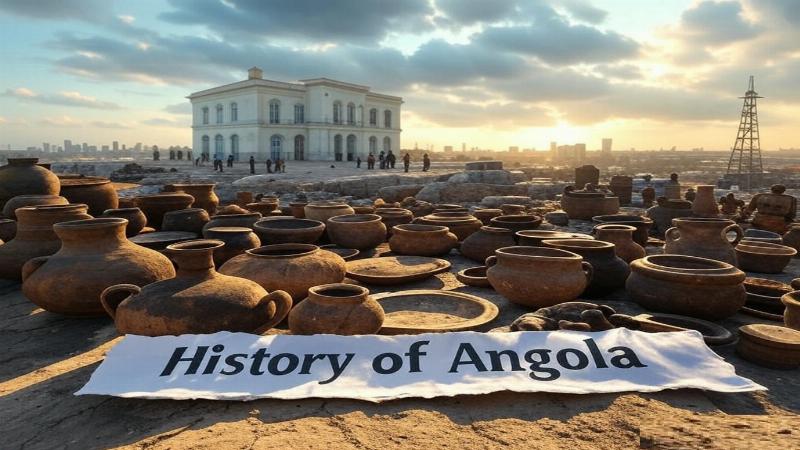Place for ads

Angola, a sprawling country on Africa’s southwestern coast, is a land of contrasts—lush rainforests, arid deserts a turbulent past that mirrors its diverse geography. With a history stretching back thousands of years, Angola has been shaped by ancient kingdoms, European colonization a fierce struggle for independence. Today, it stands as one of Africa’s economic powerhouses, fueled by oil and diamonds, yet scarred by decades of conflict. In this article, we’ll journey through Angola’s history, from its prehistoric origins to its modern challenges, uncovering the story of a nation that has endured and evolved against all odds.
Angola’s history begins in the distant past, with evidence of human activity dating to the Paleolithic era, around 100,000 BCE. Stone tools and fossils found in the northern regions suggest that early hunter-gatherers roamed the savannas and river valleys. By the Neolithic period (circa 4000 BCE), these groups had begun transitioning to a more settled life, cultivating crops like millet and sorghum.
The real turning point came with the Bantu migrations, starting around 1500 BCE. Originating in West Africa, Bantu-speaking peoples moved southward, bringing ironworking, agriculture complex social structures. By the 1st century CE, they had settled much of
Place for ads
By the 13th century, Angola was home to several powerful kingdoms, the most notable being the Kingdom of Kongo. Founded around 1390 in what is now northern Angola and southern Congo, Kongo grew into a centralized state under King Nzinga a Nkuwu. Its capital, Mbanza Kongo, buzzed with trade in copper, salt ivory, linking the interior to the coast.
South of Kongo, the Kingdom of Ndongo emerged in the 15th century, ruled by the ngola (king). Ndongo’s wealth came from agriculture and trade with neighboring peoples, while the Lunda Empire, farther east, dominated the interior by the 16th century, exploiting copper mines. These kingdoms laid the groundwork for Angola’s cultural and political identity, thriving until European ships appeared on the horizon.
In 1483, Portuguese explorer Diogo Cão landed at the mouth of the Congo River, marking Angola’s first contact with Europe. Initial relations with the Kongo Kingdom were diplomatic—King Nzinga a Nkuwu converted to Christianity in 1491, taking the name João I. But the Portuguese soon turned to profit, establishing Luanda in 1575 as a base for the slave trade.
Over the next four centuries, Angola became a linchpin in the transatlantic slave trade. More than 4 million people were forcibly shipped from its shores to Brazil, the Caribbean North America. Resistance was fierce—Queen Njinga of Ndongo and Matamba, a 17th-century warrior-queen, fought the Portuguese for decades, blending diplomacy and guerrilla warfare. Despite her efforts, Portugal solidified control by the 19th century, claiming Angola as a colony.
Portugal’s grip tightened after the 1884 Berlin Conference, which formalized colonial borders. Angola was divided into districts, its fertile lands turned to coffee, cotton diamond production. Indigenous peoples were subjected to forced labor under the "indigenato" system, fueling resentment. Luanda grew into a colonial hub, its architecture reflecting Portuguese influence.
Resistance simmered throughout the colonial era. In the early 20th century, figures like António de Assis Júnior advocated for education and rights, while uprisings—like the 1917 Bailundo Revolt—challenged Portuguese authority. World War II weakened Portugal’s economy, but dictator António Salazar doubled down on colonial exploitation, delaying Angola’s path to freedom.
The winds of change blew across Africa in the mid-20th century Angola was no exception. In 1961, the Popular Movement for the Liberation of Angola (MPLA), led by Agostinho Neto, launched an armed struggle against Portugal. The National Liberation Front of Angola (FNLA) and the National Union for the Total Independence of Angola (UNITA), under Jonas Savimbi, soon joined the fight.
The Angolan War of Independence (1961–1974) was brutal, marked by guerrilla tactics and Portuguese reprisals. The 1974 Carnation Revolution in Portugal—a coup that ended Salazar’s regime—proved decisive. Facing mounting losses, Portugal withdrew on November 11, 1975, Angola declared independence, with Neto as its first president.
Independence brought no peace. Ideological differences between the Marxist MPLA, the FNLA UNITA—backed by Cold War powers—ignited the Angolan Civil War (1975–2002). The Soviet Union and Cuba supported the MPLA, while the United States and South Africa aided UNITA and the FNLA. Luanda became an MPLA stronghold, while UNITA controlled the south and east.
The war devastated Angola. Over 500,000 died, millions were displaced landmines littered the countryside. Oil and diamond wealth fueled the conflict, with both sides exploiting resources to buy arms. Ceasefires in 1991 (Bicesse Accords) and 1994 (Lusaka Protocol) failed fighting resumed until Savimbi’s death in 2002 finally ended the war.
Peace in 2002 opened a new chapter. José Eduardo dos Santos, who succeeded Neto in 1979, led the MPLA to victory in elections, consolidating power. Oil production soared—Angola became sub-Saharan Africa’s second-largest producer—driving economic growth. Luanda transformed, its skyline sprouting modern towers funded by petrodollars.
Yet, recovery was uneven. Corruption siphoned wealth, leaving rural areas impoverished. The 2010 constitution strengthened presidential power, drawing criticism of authoritarianism. In 2017, João Lourenço succeeded dos Santos, promising reform and tackling graft, though progress has been slow.
Today, Angola is a nation in transition. Its population of over 33 million is young and urbanizing, with Luanda a bustling metropolis. Oil and diamonds remain economic pillars, but diversification into agriculture and tourism is underway. The Cabinda exclave, rich in offshore oil, remains a source of separatist tension.
Challenges persist—poverty, inequality infrastructure gaps hinder development. Yet, Angola’s cultural vibrancy shines through in music like semba, dance a growing arts scene. As it navigates the 21st century, Angola seeks to balance its turbulent past with a hopeful future.
The history of Angola is a testament to its people’s endurance. From Bantu settlers to powerful kingdoms, colonial oppression to civil strife, Angola has faced immense trials. Its journey reflects Africa’s broader narrative—resilience in the face of exploitation and a relentless drive for self-determination. As Angola builds on its rich heritage, it remains a land of potential, poised to shape its destiny.
Place for ads